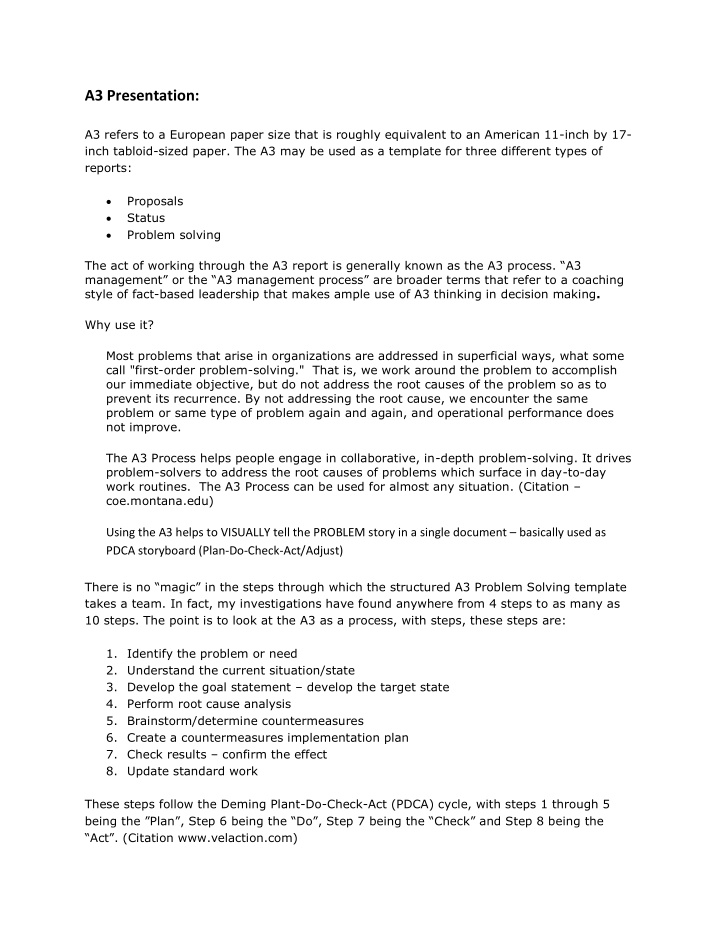



A3 Presentation: A3 refers to a European paper size that is roughly equivalent to an American 11-inch by 17- inch tabloid-sized paper. The A3 may be used as a template for three different types of reports: Proposals Status Problem solving The act of working through the A3 report is generally known as the A3 process. “A3 management” or the “A3 management process” are broader terms that refer to a coaching style of fact-based leadership that makes ample use of A3 thinking in decision making . Why use it? Most problems that arise in organizations are addressed in superficial ways, what some call "first-order problem-solving." That is, we work around the problem to accomplish our immediate objective, but do not address the root causes of the problem so as to prevent its recurrence. By not addressing the root cause, we encounter the same problem or same type of problem again and again, and operational performance does not improve. The A3 Process helps people engage in collaborative, in-depth problem-solving. It drives problem-solvers to address the root causes of problems which surface in day-to-day work routines. The A3 Process can be used for almost any situation. (Citation – coe.montana.edu) Using the A3 helps to VISUALLY tell the PROBLEM story in a single document – basically used as PDCA storyboard (Plan-Do-Check-Act/Adjust) T here is no “magic” in the steps through which the structured A3 Problem Solving template takes a team. In fact, my investigations have found anywhere from 4 steps to as many as 10 steps. The point is to look at the A3 as a process, with steps, these steps are: 1. Identify the problem or need 2. Understand the current situation/state 3. Develop the goal statement – develop the target state 4. Perform root cause analysis 5. Brainstorm/determine countermeasures 6. Create a countermeasures implementation plan 7. Check results – confirm the effect 8. Update standard work These steps follow the Deming Plant-Do-Check-Act (PDCA) cycle, with steps 1 through 5 being the ”Plan”, Step 6 being the “Do”, Step 7 being the “Check” and Step 8 being the “Act”. (Citation www.velaction.com)
This can be condensed into Four Basic Steps aligning with PDCA for A3 Development 1. PLAN - Identify Problem – What is the Pain Point? a. Planning b. Root Cause Investigation c. Identify Countermeasures 2. DO - Implement Countermeasures 3. CHECK - Analyze Results 4. ACT/ADJUST - Standardize the work – CPI An A3 should be a development/discussion vehicle – it may be used for presentation, but really better suited to sharing i nformation/ideas that the ‘team’ developed. PCDCA Storyboard Example Heading: I. Who and What II. Size and Scope III. Team members IV. Time frame Plan: I. Data derived Problem Statement, i.e. error counts, time cycles, II. Current Condition – ???? - perhaps a VSM to establish III. Analysis tools – Cause and effect diagrams – Five Why’s IV. What is the desired outcome – Goal – Measurable and time bound – Target Conditions – Ideal State Do: I. Short Term fixes – what can we do now – stop gaps! II. Long term – problem resolution – Root cause elimination III. Action Plan – who, what, where and when Check: I. What are the results of the Do? Act/Adjust I. What Adjustments were made out of Check? II. What Standards were implemented? III. Next Target – PDCA -> A3 - Next Target Footnotes I. Who reviewed and signed off on A3 report II. What else needs to be done – if anything III. back into PDCA
The A3 process lends itself to the incorporation of many Lean fundamentals/tools : I. Heading = Problem Statement - Cross walking into – Charter documents II. Plan = Kaizens - 5 Why’s – VSM’s - Fishbone III. Do = Kata – Products and Outcomes in the customers best interest IV. Check = Continual Process improvement and Change Management - Gemba walks V. Act/Adjust = CPI - Daily Kata VI. Footnotes = Can become part of Sell – Sponsor and organizational buy-in Cautions: Authors of the A3 report should feel free to adjust this problem solving tool to suit their needs, but should never stray far from the guiding principles: using the PDCA cycle, taking a team approach, back and forth communication , guidance from an experienced mentor, deeply understanding the problem, creating agreement about goals , and making decisions based on fact. (Citation velaction.com) A3 problem solving is well suited to situations where open-ended options can be implemented. If the solves are narrow and to confined/controlled the opening up and exploration of the process may not be productive. Avoid the temptation to focus on the TEMPLATE. Rather focus your conversation about the PROCESS. A good A3 is a reflection of the dialogue that created it... -John Shook – Lean Enterprise Institute Resources: Lean Enterprise Institute A3 Dojo – www.lean.org/a3dojo http://www.reliableplant.com/Read/22984/a3-problem-solving-lean http://www.coe.montana.edu/ie/faculty/sobek/a3/index.htm http://www.velaction.com/a3-thinking/ http://www.umassmed.edu/uploadedFiles/fmch/Faculty_Resources/Fall11_PelletierA3.pdf http://samples.leanpub.com/a3problemsolving-sample.pdf http://a3thinking.com/
Recommend
More recommend